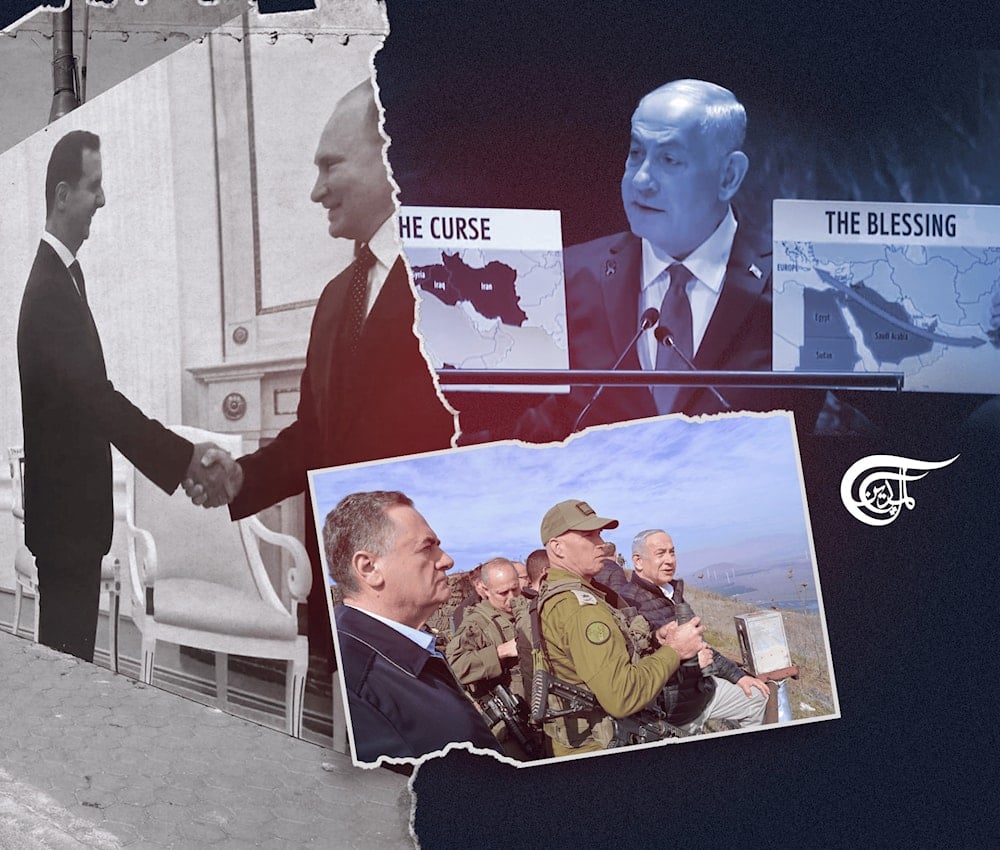The trap of diplomacy
The Axis of Resistance has not entirely ended, although it is no longer in its previous form.
-

Regarding the turning point in Syria, Iran did not abandon Assad. It appears that an understanding was reached between Trump and Putin to trade Ukraine for Syria. (Al Mayadeen English; Illustrated by Mahdi Rtail)
Diplomacy traps can be more dangerous than the threats of war, as Iranian politician Saeed Jalili has recently expressed. War traps, however, can sometimes yield remarkable outcomes. In fact, the major achievements accomplished at the national level have often been due to war traps. War demands great leaders who possess the resolve matching the cause they represent.
The first NATO war on Syria was intended to sever the Axis of Resistance and its extensions. Avoiding the chaos of a second Syrian war became crucial after the Al-Aqsa Flood battle set the course towards Jerusalem (Al-Quds). The distinction between those triumphing Resistance and the conspirators for the occupation entity has become clear.
Iran has extensive experience dealing with Western deceit and barriers. However, those who are likely to be deceived by the West’s blatant tricks are not capable of implementing its Leader's directives. Late President Raisi exemplifies a leader of this caliber, "A believer is not stung from the same hole twice." If figures like Soleimani and others were still active, the outcome would have likely been different.
Regarding the turning point in Syria, Iran did not abandon Assad. It appears that an understanding was reached between Trump and Putin to trade Ukraine for Syria. The Syrian government relied on two pillars. Firstly Russia, for international political cover at the UN and aerial support in battles against terrorism. Secondly Iran, for on-ground presence, Resistance Axis support, and logistical preparations.
Russia’s withdrawal leaves Iran at the forefront, facing sectarian wars and the resurgence of sedition. After the Al-Aqsa Flood battle and reaffirming the direction towards Jerusalem, toxic sectarianism must not return.
Over the past decade, Syria has failed to rebuild a functioning state, a failure that has drained its combat readiness. Rampant corruption complicates the mission. Strategically, avoiding a sectarian war that aligns with the West’s agenda became paramount.
Assad has given all he can within his limits of endurance, understanding, and direction. The complexities of the situation have surpassed his and his alliances' capacity. Syria remains a negotiable and exploitable arena for Moscow. The Iranian leadership prioritizes strategic interests, chief among them maintaining the focus on Jerusalem.
The Axis of Resistance has not entirely ended, although it is no longer in its previous form. However, new forms of activity may arise. The goals of the Resistance Axis have not been abandoned; however new strategies will need to be pursued. Crises can transform into genuine opportunities. The nation's awareness has advanced and is better prepared than before. The blood of martyrs fuels the nation's resolve.
New prospects include an active front emerging from Syria through cooperation with covert forces. In addition, coordination with operational groups in Syria is feasible. The Iraqi front could also play a more central role alongside Yemen. Lebanon may witness forms of action, benefiting from over a year of warfare experience.
The strategy is likely hinged on leveraging strengths within the Resistance Axis while avoiding "Israel’s" excessive destructive capabilities. New forces may also arise from Syria and Lebanon, utilizing rapid, striking operations.
The Resistance Axis shortfall was reaching this point without fully understanding the enemy's schemes. Protecting Syria without allowing room for sectarian war should have been the priority. However, given the present circumstances, avoiding a war designed to be sectarian was the wisest decision.

 Batool Subeiti
Batool Subeiti
 4 Min Read
4 Min Read











